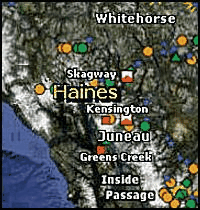Mining News: Territory offers vast mineral potential
 Click here to go directly to this story within the full PDF version of this issue, with any maps, photos or other artwork that appears in some of the articles. Click here to go directly to this story within the full PDF version of this issue, with any maps, photos or other artwork that appears in some of the articles.
Email it to an associate.
With 8 mines in development and many more early-stage projects, Nunavut is emerging as a formidable magnet for mining activity
Rose Ragsdale Mining News
There is a reason why Nunavut has one of the fastest-growing economies in Canada: mining.
With one operating gold mine at Meadowbank, two projects on the verge of startup at Hope Bay and Mary River , five projects advancing through the environmental assessment process at Meliadine, Back River, Hackett River, and the Izok corridor, and exploration activities continuing across all three regions in 2013, there’s little wonder that Nunavut’s “time has come.”
That’s the word from Matthew Spence, director general of the Northern Projects Management Office of the Canadian Northern Economic Development Agency.
“Mining has the best potential to create jobs and long-term prosperity for Nunavumiut,” Spence told an audience at the Nunavut Mining Symposium held in Iqaluit, NU in April.
In all, eight mining projects in various stages of development are currently winding their way through the regulatory assessment and permitting process in Nunavut. Representing a large number of different commodities, the ventures also will bring more than C$12 billion in capital investment and 5,000 full-time jobs to Nunavut, a mammoth territory with a sparse population of less than 35,000 residents and currently an available labor force of roughly 2000 people.
“Mining (in Nunavut) offers a broad range of direct and indirect career opportunities,” Spence said. He also noted that multi-generational opportunities are associated with many of the mine projects being developed.
Vast potential Elizabeth Kingston, general manager of the Nunavut office of the NWT & Nunavut Chamber of Mines, told the Iqaluit gathering that the tremendous mineral potential of both Nunavut and Northwest Territories made them great places to invest.
“More than C$32 billion worth of minerals have been mined since 1932 from the two territories; 44 percent was diamonds, 22 percent zinc, 18 percent gold, 9 percent lead, 4 percent tungsten, 2 percent silver, 1 percent uranium and less than 1 percent copper,” she said.
Kingston cited Nunavut’s eight geological provinces, diverse mineralogy, including gold, silver, diamonds, lead, zinc, uranium, tungsten, rare earths, cobalt, bismuth, nickel and copper, and the fact that the vast territory, roughly one-third larger than Alaska, is also under-mapped and under-explored.
She noted that the annual Fraser Institute survey of mining executives ranked Nunavut No. 7 among 93 global jurisdictions with attractive geology.
Kingston also observed that in addition to eight to 10 advanced mine projects in its development pipeline, Nunavut also boasts 10 additional promising projects – North Country Gold Corp.’s Three Bluffs, Committee Bay (gold); Stornoway Diamonds Corp.’s Hammer (diamonds); North Arrow Minerals Inc.’s Oro (gold); Prosperity Goldfields Corp.’s Kiyuk (gold); Starfield Resources Inc.’ Ferguson Lake (nickel/copper/platinum); Cameco’s Aberdeen (uranium); Canada Coal Inc.’s Nunavut Coal (coal); Commander Resources Ltd.’s Baffin Island Gold (gold); Peregrine Diamonds Ltd.’s Chidliak (diamonds); and Advanced Explorations Inc.’s Roche Bay (iron) as well as numerous early stage ventures.
Kingston said the benefits of this mining activity will add up and generate numerous training and job opportunities as well as business expenditures, government royalties, tax revenues and social assistance savings; Inuit revenues in direct royalties and shared resource revenues.
Potential benefits of mining in Nunavut from 2013-2030 include those derived from one currently operating mine and seven potential new mines; the territory’s GDP climbing to C$36 billion, total federal and territorial tax (direct + royalties) exceeding C$10 billion, nearly 100,000 person-years of employment and total income earned in Nunavut of more than C$9 billion.
Robust exploration Mineral exploration activity continues to be a bright spot in Nunavut’s economy as explorers shoveled a total of C$443 million into projects across the territory in 2012, according to Natural Resources Canada. As a result, Nunavut ranked fourth-highest among Canada’s provinces and territories in attracting mineral exploration spending.
Matthew Senkow, district geologist in the Nunavut Regional Office of Aboriginal Affairs and Northern Development Canada, told the Symposium that 31 projects – 10 gold, eight base metals, five iron; four uranium; two diamonds; one nickel-copper-platinum group elements, and one coal - were active in 2012 in Nunavut. Several projects include multiple properties and/or are multi-commodities.
Most of the investment, C$228.7 million, was focused on projects seeking precious metals, primarily gold, while base metals drew C$81.2 million; iron, C$80.5 million; uranium, C$40.2 million; diamonds, C$8.9 million and other minerals, C$3.6 million.
For 2013, NRCan projects comparable mineral exploration spending in Nunavut to decrease significantly to C$312.7 million, which is still fifth-highest in Canada. Iron and uranium will take the biggest hits in 2013, dropping to C$8.2 million and C$29.0 million, respectively. Precious metals will attract C$192.2 million, while base metals will draw C$69.9 million, and diamonds, C$3.5 million. The hunt for other minerals (nickel, copper, PGE and coal), however, will see spending nearly triple to C$10.0 million.
Policy changes Recognizing the importance of mining to the future of Nunavut’s economy, federal, territorial and other policymakers are taking steps to enhance investment and regulatory certainty in Nunavut. Recent actions to provide investment certainty include the Northern Regulatory Improvement initiative, federal Bill C-47 (Northern Jobs and Growth Act), and the Nunavut Planning & Project Assessment Act, which streamlines the project review and assessment process, Kingston said.
Policy certainty improvements include the Mineral Exploration & Mining Strategy adopted in 2007; the reinforced supportive Nunavut Uranium Policy approved in 2012; Nunavut Economic Development Strategy and Nunavut Land Use Plan (Poverty reduction) currently under way and early-stage devolution discussions.
|

 Click here to go directly to this story within the full PDF version of this issue, with any maps, photos or other artwork that appears in some of the articles.
Click here to go directly to this story within the full PDF version of this issue, with any maps, photos or other artwork that appears in some of the articles.
























